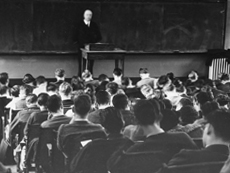Lincoln Hall Project
Surviving the Crash
Cuts to the Core

Bleak Finances
The total University income (including state funding, student tuition and fees, grants, and other measures) for fiscal year 1929 was $7.1 million. By 1932 it had dropped more than 20 percent, to its Depression-era low of $5.6 million. Most of that came by way of a drop in state funding after the treasury was slammed by falling tax receipts, but tuition and fees also fell along with a dip in enrollment. Income gradually recovered through the rest of the 1930s.
A Two-Thirds Cut
In 1932 then-Comptroller Lloyd Morey sent a stark letter to President Harry Chase. Budgeted expenses (excluding wages and salaries) for the spring semester were almost $600,000. The U of I had only $200,000 available. Chase ordered all colleges to reduce non-salary expenses immediately by two-thirds, a figure from which he refused to budge even as departments cut into their core research and teaching.

Drastic Measures
During the Great Depression the University halted construction and building improvements. Travel was restricted. College publications were put on hold. Lectures, art exhibits, and recitals were canceled. Departmental libraries were closed. Secretaries added painting and small repairs to their duties. Some 500 lab rats were exterminated as funding for nutrition experiments disappeared. Livestock for the animal husbandry program was sold as food. Class sections were eliminated. It wasn’t enough to stave off staff and salary cuts. The dean of the College of Dentistry in Chicago asked President Chase to spare the wages of cleaning women who were the “sole supports” of their families.
“I can only say,” replied Chase, in turning down the request, “that we have to do the best we can with the funds that are available.”